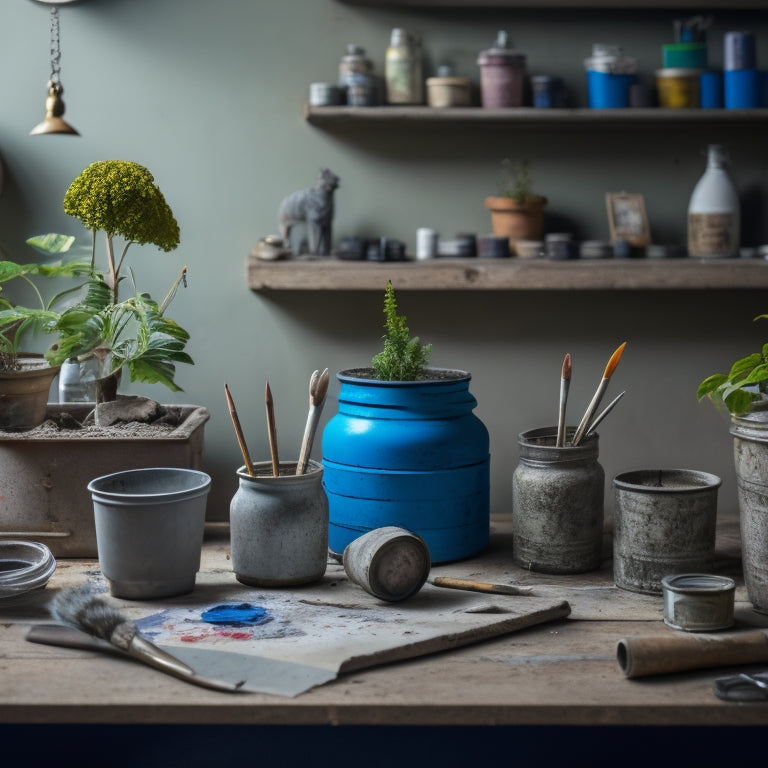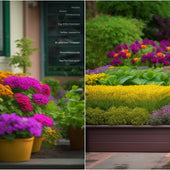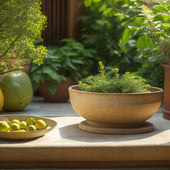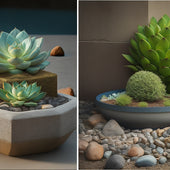
7 Best Steps to Upcycle Concrete Planters on Time
Share
You'll transform discarded cinder blocks into unique planters by following seven deliberate steps. First, prepare the blocks by cleaning and inspecting them for damage. Then, clean and disinfect the blocks to guarantee a healthy environment for plants. Add drainage holes and grout to prevent waterlogging, and sand and paint the planters for a smooth finish. Next, add decorative elements like mosaic tiles or shells. Plant and arrange your greenery thoughtfully, considering texture, color, and growth habits. Finally, seal and protect your finish to preserve your hard work. Now, get ready to bring your vision to life with the details that will take your upcycled planters to the next level.
Key Takeaways
- Clean and disinfect cinder blocks to ensure a strong foundation for upcycling, removing dirt, debris, and contaminants.
- Drill drainage holes and apply grout to prevent waterlogging and root rot, promoting healthy plant growth.
- Sand and paint the planters with exterior-grade paint, following safety guidelines and manufacturer's instructions for a durable finish.
- Add decorative elements like mosaic tiles, shells, or pebbles using strong adhesives, and arrange plants for visual appeal and harmony.
- Seal the finish with a waterproofing sealant to protect the planter from the elements and extend its lifespan.
Prepare Cinder Blocks for Upcycling
Scouring cinder blocks of dirt and debris is essential before upcycling them into planters. You'll want to source your cinder blocks from a reputable supplier or salvaged from a construction site, ensuring they're free from contaminants and hazardous materials.
Inspect each block for cracks, damage, or weak points that could compromise its structural integrity.
Next, visualize your creative design and plan the layout of your planter. Consider the size, shape, and color of the blocks, as well as the type of plants you'll be using. This will help you determine the number of blocks needed and the overall aesthetic you're aiming for.
Before you start building, take note of the block's texture and porosity. This will impact the type of adhesive or mortar you'll need to use.
You may need to add a layer of protection to prevent moisture from seeping into the block, ensuring your planter remains stable and durable. By taking these steps, you'll be well on your way to creating a beautiful, functional planter that showcases your unique design.
Clean and Disinfect the Blocks
With your design plan in place, you're ready to begin preparing the cinder blocks for upcycling. Cleaning and disinfecting the blocks is an essential step to guarantee a safe and healthy environment for your plants.
Start by sweeping away any loose debris or dirt from the blocks using a stiff-bristled brush or a handheld vacuum cleaner. Next, mix a solution of mild detergent and warm water, and use a soft-bristled brush to scrub away any stubborn stains or grime. Rinse the blocks thoroughly with clean water to remove any soap residue.
To disinfect the blocks, use effective disinfectants like bleach or a quaternary ammonium compound (quat). Always follow the manufacturer's instructions for proper dilution and application.
Apply the disinfectant solution to the blocks using a spray bottle or a soft-bristled brush, making sure to cover all surfaces evenly. Let the solution sit for the recommended amount of time before rinsing the blocks with clean water.
Add Drainage Holes and Grout
About six to eight holes, spaced evenly apart, will be needed on the bottom of each cinder block to guarantee proper drainage for your plants. Use a drill with a masonry bit to create these holes, taking care not to apply too much pressure, which can crack the block.
Once the holes are drilled, move on to applying grout to fill in any gaps or crevices on the block's surface. Choose a grout type suitable for outdoor use, such as epoxy-based or polyurethane-based grout, to make certain it can withstand weather conditions.
When applying grout, use a grout float to spread it evenly and wipe away excess with a damp cloth. Allow the grout to dry completely before moving on to the next step.
Proper drainage solutions are essential to prevent waterlogged soil and root rot. By adding these holes and grout, you'll create a healthy environment for your plants to thrive.
Take your time and work methodically to make certain a successful upcycle.
Sand and Paint the Planters
Once you've guaranteed your planters have proper drainage and a solid grout job, it's time to give them a smooth finish by sanding the surface. This step is essential in preparing the planters for painting, as it helps create a uniform surface for the paint to adhere to.
Use a fine-grit sandpaper to remove any imperfections or rough spots, and work your way up to a higher grit for a smooth finish.
When it comes to painting, consider the following:
-
Choose a color scheme that complements your outdoor decor: Select a color that blends with your outdoor furniture, walls, or surrounding plants to create a cohesive look.
-
Select the right paint for the job: Use a high-quality, exterior-grade paint specifically designed for concrete or masonry surfaces.
-
Experiment with different paint techniques: Try using a primer, applying a base coat, and finishing with a topcoat for a durable, long-lasting finish.
Remember to follow safety guidelines when working with paint and sandpaper, including wearing protective gear and working in a well-ventilated area.
With a smooth, painted finish, your upcycled planters will be ready to showcase your favorite plants and greenery.
Add Decorative Finishing Touches
Now that your planters boast a smooth, painted finish, it's time to add the icing on the cake - decorative finishing touches that will elevate their visual appeal and make them truly unique.
To start, consider adding mosaic tiles to create an eye-catching pattern or design. You can arrange the tiles in a subtle, monochromatic scheme or go bold with a contrasting color scheme that complements the planter's base color. Make sure to use a strong adhesive, like epoxy or thinset, to secure the tiles in place.
Next, think about adding some texture with decorative elements like shells, pebbles, or even seashells. You can create a cohesive look by selecting elements that match your chosen color scheme.
For a more whimsical touch, try adding a few decorative stickers or decals that reflect your personal style. Whatever you choose, be sure to follow the manufacturer's instructions and take necessary safety precautions to avoid accidents.
With these finishing touches, your planters will be transformed into one-of-a-kind masterpieces that showcase your creativity and style.
Plant and Arrange Greenery
With your upcycled concrete planters boasting a fresh coat of paint and decorative finishing touches, it's time to bring them to life by planting and arranging lush greenery.
When selecting plants, consider the planter's size, material, and the amount of sunlight it'll receive. Choose plants that thrive in similar conditions, ensuring a harmonious and low-maintenance arrangement.
For a visually appealing display, balance plants with varying textures, colors, and growth habits.
To create a stunning arrangement, follow these techniques:
-
Group plants by texture: Combine plants with smooth, velvety, or prickly textures to add depth and interest.
-
Play with scale: Mix plants of varying heights to create a dynamic, layered look.
-
Leave breathing room: Don't overcrowd the planter, allowing each plant to grow and receive adequate air circulation.
Seal and Protect the Finish
Because your upcycled concrete planters have been painted and decorated, they require a protective sealant to preserve the finish and prevent damage from the elements or plant care.
Applying a sealant guarantees the longevity of your design and protects the planter from water, UV rays, and extreme temperatures.
Choose a waterproofing sealant specifically designed for concrete and outdoor use.
Follow the manufacturer's instructions for application, usually a thin, even coat using a foam brush or roller.
Verify the sealant is fully dry before exposing the planter to water or plants.
To achieve maximum finish longevity, apply a second coat according to the manufacturer's instructions.
This will provide an extra layer of protection against the elements and plant care.
Regularly inspect your planters for signs of wear, and reapply the sealant as needed.
Frequently Asked Questions
Can I Upcycle Concrete Planters With Cracks or Broken Edges?
You can definitely upcycle concrete planters with cracks or broken edges; just assess the damage, apply repair techniques like epoxy or concrete patching, and then add decorative finishes like paint or stain to conceal any imperfections.
How Long Does It Take for Grout to Fully Dry and Harden?
As you gaze out the window, watching the morning dew evaporate, you're wondering when your grout will follow suit. Typically, grout drying occurs within 24 hours, but curing takes 3-7 days, depending on humidity and temperature, so be patient and let it set.
Can I Use Oil-Based Paints on Concrete Planters?
You can use oil-based paints on concrete planters, but guarantee proper surface preparation to achieve a strong bond, as oil paint benefits from a porous surface; clean, etch, and prime the concrete to secure a durable, long-lasting finish.
Will Sealing the Planter Affect Plant Growth or Drainage?
Curiously, you're considering the same dilemma many gardeners face! When sealing your planter, you'll want to choose a breathable method to maintain plant health, ensuring proper drainage and aeration to prevent waterlogged soil and root rot.
Are Concrete Planters Suitable for Indoor or Outdoor Use Only?
When choosing a concrete planter, you'll want to contemplate indoor aesthetics, as they can bring a touch of industrial chic to your space, or opt for outdoor durability, ensuring it withstands the elements, but always prioritize safety by following manufacturer guidelines.
Conclusion
You've transformed dull cinder blocks into stunning planters, just like a master artist breathing life into a blank canvas. Remember, upcycling is like gardening - it requires patience, nurturing, and attention to detail. Just as a seedling needs time to bloom, your creative vision needs time to unfold. With these 7 steps, you've not only given old concrete a new lease on life but also cultivated a sense of pride and accomplishment. Now, sit back, admire your handiwork, and let your planters flourish!
Related Posts
-

Optimal Soil Ph for Planter Boxes Made Easy
You need to optimize your planter box's soil pH to create a thriving environment for your plants, as the ideal pH ran...
-

Optimal Soil Ph for Planter Boxes Made Easy
You need to optimize your planter box's soil pH to create a thriving environment for your plants, as the ideal pH ran...
-

Optimal Soil Ph for Planter Boxes Made Easy
You need to optimize your planter box's soil pH to create a thriving environment for your plants, as the ideal pH ran...
-

Optimal Soil Ph for Planter Boxes Made Easy
You need to optimize your planter box's soil pH to create a thriving environment for your plants, as the ideal pH ran...
-

Optimal Soil Ph for Planter Boxes Made Easy
You need to optimize your planter box's soil pH to create a thriving environment for your plants, as the ideal pH ran...
-

Optimal Soil Ph for Planter Boxes Made Easy
You need to optimize your planter box's soil pH to create a thriving environment for your plants, as the ideal pH ran...
-

Optimal Soil Ph for Planter Boxes Made Easy
You need to optimize your planter box's soil pH to create a thriving environment for your plants, as the ideal pH ran...
-

Optimal Soil Ph for Planter Boxes Made Easy
You need to optimize your planter box's soil pH to create a thriving environment for your plants, as the ideal pH ran...
-

Optimal Soil Ph for Planter Boxes Made Easy
You need to optimize your planter box's soil pH to create a thriving environment for your plants, as the ideal pH ran...
-

Optimal Soil Ph for Planter Boxes Made Easy
You need to optimize your planter box's soil pH to create a thriving environment for your plants, as the ideal pH ran...
-

Optimal Soil Ph for Planter Boxes Made Easy
You need to optimize your planter box's soil pH to create a thriving environment for your plants, as the ideal pH ran...
-

Optimal Soil Ph for Planter Boxes Made Easy
You need to optimize your planter box's soil pH to create a thriving environment for your plants, as the ideal pH ran...
-

Optimal Soil Ph for Planter Boxes Made Easy
You need to optimize your planter box's soil pH to create a thriving environment for your plants, as the ideal pH ran...
-

Optimal Soil Ph for Planter Boxes Made Easy
You need to optimize your planter box's soil pH to create a thriving environment for your plants, as the ideal pH ran...
-

Optimal Soil Ph for Planter Boxes Made Easy
You need to optimize your planter box's soil pH to create a thriving environment for your plants, as the ideal pH ran...
-

Optimal Soil Ph for Planter Boxes Made Easy
You need to optimize your planter box's soil pH to create a thriving environment for your plants, as the ideal pH ran...
-

Optimal Soil Ph for Planter Boxes Made Easy
You need to optimize your planter box's soil pH to create a thriving environment for your plants, as the ideal pH ran...
-

Optimal Soil Ph for Planter Boxes Made Easy
You need to optimize your planter box's soil pH to create a thriving environment for your plants, as the ideal pH ran...
-

Optimal Soil Ph for Planter Boxes Made Easy
You need to optimize your planter box's soil pH to create a thriving environment for your plants, as the ideal pH ran...
-

Optimal Soil Ph for Planter Boxes Made Easy
You need to optimize your planter box's soil pH to create a thriving environment for your plants, as the ideal pH ran...
-

Optimal Soil Ph for Planter Boxes Made Easy
You need to optimize your planter box's soil pH to create a thriving environment for your plants, as the ideal pH ran...
-

Optimal Soil Ph for Planter Boxes Made Easy
You need to optimize your planter box's soil pH to create a thriving environment for your plants, as the ideal pH ran...
-

Optimal Soil Ph for Planter Boxes Made Easy
You need to optimize your planter box's soil pH to create a thriving environment for your plants, as the ideal pH ran...
-

Optimal Soil Ph for Planter Boxes Made Easy
You need to optimize your planter box's soil pH to create a thriving environment for your plants, as the ideal pH ran...
-

Optimal Soil Ph for Planter Boxes Made Easy
You need to optimize your planter box's soil pH to create a thriving environment for your plants, as the ideal pH ran...
-

Optimal Soil Ph for Planter Boxes Made Easy
You need to optimize your planter box's soil pH to create a thriving environment for your plants, as the ideal pH ran...
-

10 Natural Ways to Clean Your Planters
You can transform your planters from grimy to gleaming with these 10 natural cleaning solutions. Mix baking soda and ...
-

10 Natural Ways to Clean Your Planters
You can transform your planters from grimy to gleaming with these 10 natural cleaning solutions. Mix baking soda and ...
-

10 Natural Ways to Clean Your Planters
You can transform your planters from grimy to gleaming with these 10 natural cleaning solutions. Mix baking soda and ...
-

10 Natural Ways to Clean Your Planters
You can transform your planters from grimy to gleaming with these 10 natural cleaning solutions. Mix baking soda and ...
-

10 Natural Ways to Clean Your Planters
You can transform your planters from grimy to gleaming with these 10 natural cleaning solutions. Mix baking soda and ...
-

10 Natural Ways to Clean Your Planters
You can transform your planters from grimy to gleaming with these 10 natural cleaning solutions. Mix baking soda and ...
-

10 Natural Ways to Clean Your Planters
You can transform your planters from grimy to gleaming with these 10 natural cleaning solutions. Mix baking soda and ...
-

10 Natural Ways to Clean Your Planters
You can transform your planters from grimy to gleaming with these 10 natural cleaning solutions. Mix baking soda and ...
-

10 Natural Ways to Clean Your Planters
You can transform your planters from grimy to gleaming with these 10 natural cleaning solutions. Mix baking soda and ...
-

10 Natural Ways to Clean Your Planters
You can transform your planters from grimy to gleaming with these 10 natural cleaning solutions. Mix baking soda and ...
-

10 Natural Ways to Clean Your Planters
You can transform your planters from grimy to gleaming with these 10 natural cleaning solutions. Mix baking soda and ...
-

10 Natural Ways to Clean Your Planters
You can transform your planters from grimy to gleaming with these 10 natural cleaning solutions. Mix baking soda and ...
-

10 Natural Ways to Clean Your Planters
You can transform your planters from grimy to gleaming with these 10 natural cleaning solutions. Mix baking soda and ...
-

10 Natural Ways to Clean Your Planters
You can transform your planters from grimy to gleaming with these 10 natural cleaning solutions. Mix baking soda and ...
-

10 Natural Ways to Clean Your Planters
You can transform your planters from grimy to gleaming with these 10 natural cleaning solutions. Mix baking soda and ...
-

10 Natural Ways to Clean Your Planters
You can transform your planters from grimy to gleaming with these 10 natural cleaning solutions. Mix baking soda and ...
-

10 Natural Ways to Clean Your Planters
You can transform your planters from grimy to gleaming with these 10 natural cleaning solutions. Mix baking soda and ...
-

10 Natural Ways to Clean Your Planters
You can transform your planters from grimy to gleaming with these 10 natural cleaning solutions. Mix baking soda and ...
-

10 Natural Ways to Clean Your Planters
You can transform your planters from grimy to gleaming with these 10 natural cleaning solutions. Mix baking soda and ...
-

10 Natural Ways to Clean Your Planters
You can transform your planters from grimy to gleaming with these 10 natural cleaning solutions. Mix baking soda and ...
-

10 Natural Ways to Clean Your Planters
You can transform your planters from grimy to gleaming with these 10 natural cleaning solutions. Mix baking soda and ...
-

10 Natural Ways to Clean Your Planters
You can transform your planters from grimy to gleaming with these 10 natural cleaning solutions. Mix baking soda and ...
-

10 Natural Ways to Clean Your Planters
You can transform your planters from grimy to gleaming with these 10 natural cleaning solutions. Mix baking soda and ...
-

10 Natural Ways to Clean Your Planters
You can transform your planters from grimy to gleaming with these 10 natural cleaning solutions. Mix baking soda and ...
-

10 Natural Ways to Clean Your Planters
You can transform your planters from grimy to gleaming with these 10 natural cleaning solutions. Mix baking soda and ...
-

10 Natural Ways to Clean Your Planters
You can transform your planters from grimy to gleaming with these 10 natural cleaning solutions. Mix baking soda and ...
-

10 Natural Ways to Clean Your Planters
You can transform your planters from grimy to gleaming with these 10 natural cleaning solutions. Mix baking soda and ...
-

10 Natural Ways to Clean Your Planters
You can transform your planters from grimy to gleaming with these 10 natural cleaning solutions. Mix baking soda and ...
-

10 Natural Ways to Clean Your Planters
You can transform your planters from grimy to gleaming with these 10 natural cleaning solutions. Mix baking soda and ...
-

10 Natural Ways to Clean Your Planters
You can transform your planters from grimy to gleaming with these 10 natural cleaning solutions. Mix baking soda and ...
-

10 Natural Ways to Clean Your Planters
You can transform your planters from grimy to gleaming with these 10 natural cleaning solutions. Mix baking soda and ...
-

10 Natural Ways to Clean Your Planters
You can transform your planters from grimy to gleaming with these 10 natural cleaning solutions. Mix baking soda and ...
-

10 Natural Ways to Clean Your Planters
You can transform your planters from grimy to gleaming with these 10 natural cleaning solutions. Mix baking soda and ...
-

10 Natural Ways to Clean Your Planters
You can transform your planters from grimy to gleaming with these 10 natural cleaning solutions. Mix baking soda and ...
-

10 Natural Ways to Clean Your Planters
You can transform your planters from grimy to gleaming with these 10 natural cleaning solutions. Mix baking soda and ...
-

Succulent-Friendly Drainage Solutions for Block Planters
You can create a succulent-friendly drainage system in your cinder block planters by drilling holes in the bottom of ...
-

Succulent-Friendly Drainage Solutions for Block Planters
You can create a succulent-friendly drainage system in your cinder block planters by drilling holes in the bottom of ...
-

Succulent-Friendly Drainage Solutions for Block Planters
You can create a succulent-friendly drainage system in your cinder block planters by drilling holes in the bottom of ...
-

Succulent-Friendly Drainage Solutions for Block Planters
You can create a succulent-friendly drainage system in your cinder block planters by drilling holes in the bottom of ...
-

Succulent-Friendly Drainage Solutions for Block Planters
You can create a succulent-friendly drainage system in your cinder block planters by drilling holes in the bottom of ...
-

Succulent-Friendly Drainage Solutions for Block Planters
You can create a succulent-friendly drainage system in your cinder block planters by drilling holes in the bottom of ...
-

Succulent-Friendly Drainage Solutions for Block Planters
You can create a succulent-friendly drainage system in your cinder block planters by drilling holes in the bottom of ...
-

Succulent-Friendly Drainage Solutions for Block Planters
You can create a succulent-friendly drainage system in your cinder block planters by drilling holes in the bottom of ...
-

Succulent-Friendly Drainage Solutions for Block Planters
You can create a succulent-friendly drainage system in your cinder block planters by drilling holes in the bottom of ...
-

Succulent-Friendly Drainage Solutions for Block Planters
You can create a succulent-friendly drainage system in your cinder block planters by drilling holes in the bottom of ...
-

Succulent-Friendly Drainage Solutions for Block Planters
You can create a succulent-friendly drainage system in your cinder block planters by drilling holes in the bottom of ...
-

Succulent-Friendly Drainage Solutions for Block Planters
You can create a succulent-friendly drainage system in your cinder block planters by drilling holes in the bottom of ...
-

Succulent-Friendly Drainage Solutions for Block Planters
You can create a succulent-friendly drainage system in your cinder block planters by drilling holes in the bottom of ...
-

Succulent-Friendly Drainage Solutions for Block Planters
You can create a succulent-friendly drainage system in your cinder block planters by drilling holes in the bottom of ...
-

Succulent-Friendly Drainage Solutions for Block Planters
You can create a succulent-friendly drainage system in your cinder block planters by drilling holes in the bottom of ...


